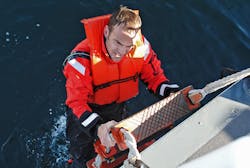A veteran U.S. Coast Guard chief petty officer was killed Sunday after suspected smugglers rammed his vessel near Santa Cruz Island, casting him into the ocean with a fatal head wound.
Chief Petty Officer Terrell Horne III, 34, of Redondo Beach was second in command of the Halibut, an 87-foot patrol cutter based in Marina del Rey. Authorities said they could not recall a Coast Guard chief petty officer being killed in such a manner off the coast of California.
Early Sunday morning, the Halibut was dispatched to investigate a boat operating near Santa Cruz Island, the largest of California's eight Channel Islands. The island is roughly 25 miles southwest of Oxnard.
The boat, first detected by a patrol plane, had fallen under suspicion because it was operating in the middle of the night without lights and was a "panga"-style vessel, an open-hulled boat that has become "the choice of smugglers operating off the coast of California," said Coast Guard spokesman Adam Eggers.
The Coast Guard cutter contains a smaller boat -- a rigid-hull inflatable used routinely for search-and-rescue operations and missions that require a nimble approach. When Horne and his team approached in the inflatable, the suspect boat gunned its engine, maneuvered directly toward the Coast Guard inflatable, rammed it and fled.
The impact knocked Horne and another Coast Guardsman into the water. Both were quickly plucked from the sea. Horne had suffered a traumatic head injury. While receiving medical care, he was raced to shore aboard the Halibut. Paramedics met the Halibut at the pier in Port Hueneme and declared Horne dead at 2:21 a.m.
"We are deeply saddened by the loss of our shipmate," said Adm. Robert J. Papp, the Coast Guard commandant. "Our fallen shipmate stood the watch on the front lines protecting our nation, and we are all indebted to him for his service and sacrifice."
The second crew member knocked into the water suffered minor injuries and was treated and released from a hospital later Sunday. He was not identified.
Using a helicopter and a 45-foot boat stationed in Los Angeles, the Coast Guard later found the panga and stopped it.
Two men were detained. The Coast Guard declined to identify them or say whether drugs were found aboard the boat. A second suspicious vessel was believed to have been traveling alongside the panga before the incident.
"We are actively working to ensure that all of the individuals involved in this illegal activity are brought to justice," said Coast Guard Capt. James Jenkins.
The Coast Guard was unable to provide a detailed account of Horne's service.
He had been heralded by the agency on several occasions.
He appears to have arrived in Southern California last summer after serving for two years as an executive petty officer in Emerald Isle, N.C. There, he received a Coast Guard Commendation Medal for his leadership in 63 search-and-rescue cases, in which 38 lives were saved.
According to an account of the medal ceremony, the most notable of those operations involved a boat that capsized in a North Carolina inlet in 2010. The account said he coached his team through "treacherous" sea conditions to rescue five people.
The Coast Guard also noted Horne's involvement in a January operation in which the Halibut found and stopped two boats operating at midnight with
no lights. The boats contained 2,000 pounds of marijuana.
In the last five years, as U.S. authorities have become increasingly successful at blocking traditional land routes, smugglers have taken increasingly to the sea -- ferrying both drugs and immigrants. Authorities believe a smuggling vessel is launched toward California every three days; the number of immigrants and smugglers arrested at sea or along the coast more than doubled to 867 in 2010 from the previous year.
Drug runners and human smugglers have run ashore at a dog beach in Del Mar, at Crystal Cove in Orange County and next to the San Onofre nuclear power plant. Border Patrol agents have been diverted from land to sea, and an agency supervisor recently called the ocean "the front line."
The eruption in sea-based smuggling has created the same cat-and-mouse game in the ocean that has long existed along the U.S.-Mexico border. Smuggling boats often travel without lights and at a slow speed to limit their wakes. When U.S. agents began disrupting routes into San Diego beaches, smugglers began conducting counter-surveillance, using radios to direct boat pilots to unguarded beaches.
Copyright 2012 - Los Angeles Times
McClatchy-Tribune News Service



